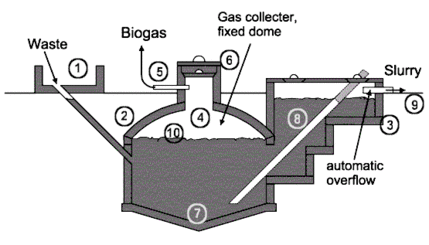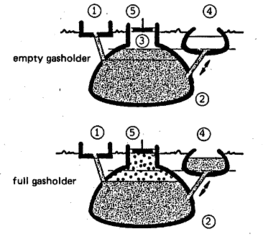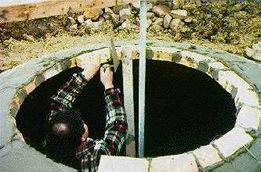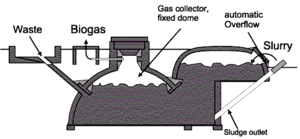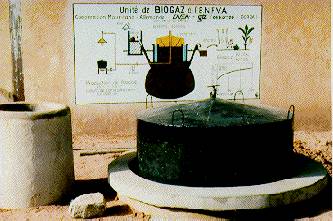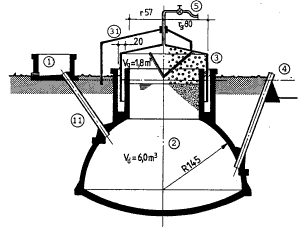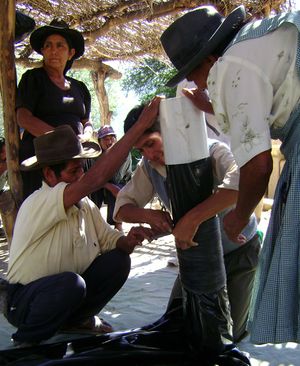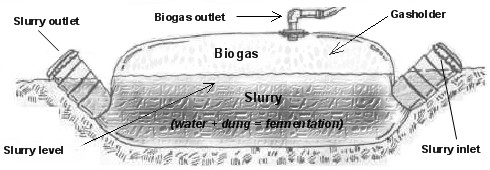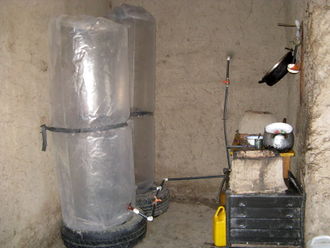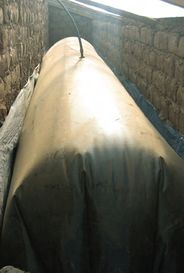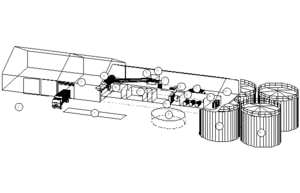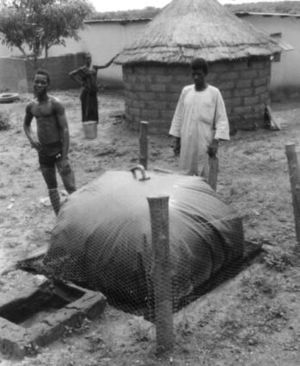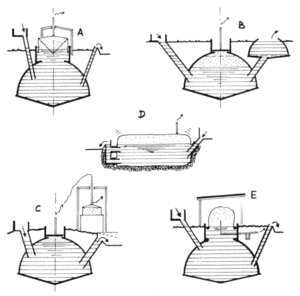Knowledge fuels change
For over a decade, Energypedia has shared free, reliable energy expertise with the world.
We’re now facing a serious funding gap.
Help keep this platform alive — your donation, big or small, truly matters!
Thank you for your support
Difference between revisions of "Fixed-dome Biogas Plants"
***** (***** | *****) m |
***** (***** | *****) |
||
| Line 71: | Line 71: | ||
<br/> | <br/> | ||
| + | |||
= Fixed-dome Plants<br/> = | = Fixed-dome Plants<br/> = | ||
| − | A fixed-dome plant consists of a digester with a fixed, non-movable gas holder, which sits on top of the digester. When gas production starts, the slurry is displaced into the compensation tank. Gas pressure increases with the volume of gas stored and the height difference between the slurry level in the digester and the slurry level in the compensation tank. The costs of a fixed-dome <span data-scayt_word="biogas" data-scaytid="37">biogas</span> plant are relatively low. It is simple as no moving parts exist. There are also no rusting steel parts and hence a long life of the plant (20 years or more) can be expected. The plant is constructed underground, protecting it from physical damage and saving space. While the underground digester is protected from low temperatures at night and during cold seasons, sunshine and warm seasons take longer to heat up the digester. No day/night fluctuations of temperature in the digester positively influence the bacteriological processes. The construction of fixed dome plants is labor-intensive, thus creating local employment. Fixed-dome plants are not easy to build. They should only be built where construction can be supervised by experienced biogas technicians. Otherwise plants may not be gas-tight (porosity and cracks).<br/> | + | A fixed-dome plant consists of a digester with a fixed, non-movable gas holder, which sits on top of the digester. When gas production starts, the slurry is displaced into the compensation tank. Gas pressure increases with the volume of gas stored and the height difference between the slurry level in the digester and the slurry level in the compensation tank. The costs of a fixed-dome <span data-scayt_word="biogas" data-scaytid="37">biogas</span> plant are relatively low. It is simple as no moving parts exist. There are also no rusting steel parts and hence a long life of the plant (20 years or more) can be expected. The plant is constructed underground, protecting it from physical damage and saving space. While the underground digester is protected from low temperatures at night and during cold seasons, sunshine and warm seasons take longer to heat up the digester. No day/night fluctuations of temperature in the digester positively influence the bacteriological processes. The construction of fixed dome plants is labor-intensive, thus creating local employment. Fixed-dome plants are not easy to build. They should only be built where construction can be supervised by experienced biogas technicians. Otherwise plants may not be gas-tight (porosity and cracks).<br/> |
| − | <br/> | + | <br/>The basic elements of a fixed dome plant (here the Nicarao Design) are shown in the figure below. |
{| cellspacing="0" cellpadding="0" border="0" align="center" style="width: 100%" class="FCK__ShowTableBorders" | {| cellspacing="0" cellpadding="0" border="0" align="center" style="width: 100%" class="FCK__ShowTableBorders" | ||
| Line 86: | Line 87: | ||
<br/> | <br/> | ||
| − | [[Fixed-dome_Biogas_Plants#toc| | + | [[Fixed-dome_Biogas_Plants#toc|►Go to Top]]<br/> |
== Function == | == Function == | ||
| Line 94: | Line 95: | ||
<br/> | <br/> | ||
| − | [[Fixed-dome_Biogas_Plants#toc| | + | [[Fixed-dome_Biogas_Plants#toc|►Go to Top]]<br/> |
== Digester == | == Digester == | ||
| Line 131: | Line 132: | ||
<br/> | <br/> | ||
| − | [[Fixed-dome_Biogas_Plants#toc| | + | [[Fixed-dome_Biogas_Plants#toc|►Go to Top]]<br/> |
== Gas-Holder == | == Gas-Holder == | ||
| Line 139: | Line 140: | ||
<br/> | <br/> | ||
| − | [[Fixed-dome_Biogas_Plants#toc| | + | [[Fixed-dome_Biogas_Plants#toc|►Go to Top]]<br/> |
== Types of Fixed-dome Plants<br/> == | == Types of Fixed-dome Plants<br/> == | ||
| Line 158: | Line 159: | ||
<br/> | <br/> | ||
| − | [[Fixed-dome_Biogas_Plants#toc| | + | [[Fixed-dome_Biogas_Plants#toc|►Go to Top]]<br/> |
== Climate and Size<br/> == | == Climate and Size<br/> == | ||
| Line 166: | Line 167: | ||
<br/> | <br/> | ||
| − | [[Fixed-dome_Biogas_Plants#toc| | + | [[Fixed-dome_Biogas_Plants#toc|►Go to Top]]<br/> |
== Summary == | == Summary == | ||
| Line 176: | Line 177: | ||
<br/> | <br/> | ||
| − | [[Fixed-dome_Biogas_Plants#toc| | + | [[Fixed-dome_Biogas_Plants#toc|►Go to Top]]<br/> |
| + | |||
= Floating-drum Plants<br/> = | = Floating-drum Plants<br/> = | ||
Revision as of 10:07, 31 August 2015
Overview
There are different types of small scale biogas digesters. Some of the biogas digesters are summarized below:
The table below gives a first comparision of the different types.
Factors |
Fixed dome |
Floating drum |
Tubular design |
Plastic containers |
|---|---|---|---|---|
Gas storage |
Internal Gas storage up to 20 m³ (large) |
Internal Gas storage drum size (small) |
Internal eventually external plastic bags |
Internal Gas storage drum sizes (small) |
Gas pressure |
Between 60 and 120 mbar |
Upto 20 mbar |
Low, around 2 mbar |
Low around 2mbar |
Skills of contractor |
High; masonry, plumbing |
High; masonry, plumbing, welding |
Medium; plumbing |
Low; plumbing |
Availability of Material |
yes |
yes |
yes |
yes |
Durability |
Very high >20 years |
High; drum is weakness |
Medium; Depending on chosen liner |
Medium
|
Agitation |
Self agitated by Biogas pressure |
Manual steering |
Not possible; plug flow type |
Evtl Manual steering |
Sizing |
6 to 124 m³ digester vol |
Up to 20 m³ |
Combination possible |
Up to 6 m³ digester vol |
Methane emission |
High |
Medium |
Low |
Medium |
Fixed-dome Plants
A fixed-dome plant consists of a digester with a fixed, non-movable gas holder, which sits on top of the digester. When gas production starts, the slurry is displaced into the compensation tank. Gas pressure increases with the volume of gas stored and the height difference between the slurry level in the digester and the slurry level in the compensation tank. The costs of a fixed-dome biogas plant are relatively low. It is simple as no moving parts exist. There are also no rusting steel parts and hence a long life of the plant (20 years or more) can be expected. The plant is constructed underground, protecting it from physical damage and saving space. While the underground digester is protected from low temperatures at night and during cold seasons, sunshine and warm seasons take longer to heat up the digester. No day/night fluctuations of temperature in the digester positively influence the bacteriological processes. The construction of fixed dome plants is labor-intensive, thus creating local employment. Fixed-dome plants are not easy to build. They should only be built where construction can be supervised by experienced biogas technicians. Otherwise plants may not be gas-tight (porosity and cracks).
The basic elements of a fixed dome plant (here the Nicarao Design) are shown in the figure below.
Function
A fixed-dome plant comprises of a closed, dome-shaped digester with an immovable, rigid gas-holder and a displacement pit, also named 'compensation tank'. The gas is stored in the upper part of the digester. When gas production commences, the slurry is displaced into the compensating tank. Gas pressure increases with the volume of gas stored, i.e. with the height difference between the two slurry levels. If there is little gas in the gas-holder, the gas pressure is low.
Digester
The digesters of fixed-dome plants are usually masonry structures, structures of cement and ferro-cement exist. Main parameters for the choice of material are:
|
Fixed dome plants produce just as much gas as floating-drum plants, if they are gas-tight. However, utilization of the gas is less effective as the gas pressure fluctuates substantially. Burners and other simple appliances cannot be set in an optimal way. If the gas is required at constant pressure (e.g., for engines), a gas pressure regulator or a floating gas-holder is necessary.
Gas-Holder
The top part of a fixed-dome plant (the gas space) must be gas-tight. Concrete, masonry and cement rendering are not gas-tight. The gas space must therefore be painted with a gas-tight layer (e.g. 'Water-proofer', Latex or synthetic paints). A possibility to reduce the risk of cracking of the gas-holder consists in the construction of a weak-ring in the masonry of the digester. This "ring" is a flexible joint between the lower (water-proof) and the upper (gas-proof) part of the hemispherical structure. It prevents cracks that develop due to the hydrostatic pressure in the lower parts to move into the upper parts of the gas-holder.
Types of Fixed-dome Plants
|
Climate and Size
Fixed-dome plants must be covered with earth up to the top of the gas-filled space to counteract the internal pressure (up to 0,15 bar). The earth cover insulation and the option for internal heating makes them suitable for colder climates. Due to economic parameters, the recommended minimum size of a fixed-dome plant is 5 m3. Digester volumes up to 200 m3 are known and possible.
Summary
Advantages: Low initial costs and long useful life-span; no moving or rusting parts involved; basic design is compact, saves space and is well insulated; construction creates local employment. Advantages are the relatively low construction costs, the absence of moving parts and rusting steel parts. If well constructed, fixed dome plants have a long life span. The underground construction saves space and protects the digester from temperature changes. The construction provides opportunities for skilled local employment.
Disadvantages: Masonry gas-holders require special sealants and high technical skills for gas-tight construction; gas leaks occur quite frequently; fluctuating gas pressure complicates gas utilization; amount of gas produced is not immediately visible, plant operation not readily understandable; fixed dome plants need exact planning of levels; excavation can be difficult and expensive in bedrock. Disadvantages are mainly the frequent problems with the gas-tightness of the brickwork gas holder (a small crack in the upper brickwork can cause heavy losses of biogas). Fixed-dome plants are, therefore, recommended only where construction can be supervised by experienced biogas technicians. The gas pressure fluctuates substantially depending on the volume of the stored gas. Even though the underground construction buffers temperature extremes, digester temperatures are generally low. Fixed dome plants can be recommended only where construction can be supervised by experienced biogas technicians.
A specific environmental disadvantage is methane emission from the expansion chamber.
Variations: Some companies are now looking into small pre-fab fixed dome plants made of fibreglass which appears to be a low cost alternative to construction intensive masoned plants. A custom made plant can be produced in 2 days and -after transport- installed in less than 1 day!
Floating-drum Plants
|
Floating-drum plants consist of an underground digester and a moving gas-holder. The gas-holder floats either directly on the fermentation slurry or in a water jacket of its own. The gas is collected in the gas drum, which rises or moves down, according to the amount of gas stored. The gas drum is prevented from tilting by a guiding frame. If the drum floats in a water jacket, it cannot get stuck, even in substrate with high solid content. |
Solar Energy for Electricity and Heat in Chile
The Drum
In the past, floating-drum plants were mainly built in India. A floating-drum plant consists of a cylindrical or dome-shaped digester and a moving, floating gas-holder, or drum. The gas-holder floats either directly in the fermenting slurry or in a separate water jacket. The drum in which the biogas collects has an internal and/or external guide frame that provides stability and keeps the drum upright. If biogas is produced, the drum moves up, if gas is consumed, the gas-holder sinks back.
Solar Energy for Electricity and Heat in Chile
Size
Floating-drum plants are used chiefly for digesting animal and human feces on a continuous-feed mode of operation, i.e. with daily input. They are used most frequently by small- to middle-sized farms (digester size: 5-15m3) or in institutions and larger agro-industrial estates (digester size: 20-100m3). Disadvantages: The steel drum is relatively expensive and maintenance-intensive. Removing rust and painting has to be carried out regularly. The life-time of the drum is short (up to 15 years; in tropical coastal regions about five years). If fibrous substrates are used, the gas-holder shows a tendency to get "stuck" in the resultant floating scum.
Solar Energy for Electricity and Heat in Chile
Water-jacket Floating-drum Plants
Water-jacket plants are universally applicable and easy to maintain. The drum cannot get stuck in a scum layer, even if the substrate has a high solids content. Water-jacket plants are characterized by a long useful life and a more aesthetic appearance (no dirty gas-holder). Due to their superior sealing of the substrate (hygiene!), they are recommended for use in the fermentation of night soil. The extra cost of the masonry water jacket is relatively modest.
Solar Energy for Electricity and Heat in Chile
Material of Digester and Drum
The digester is usually made of brick, concrete or quarry-stone masonry with plaster. The gas drum normally consists of 2.5 mm steel sheets for the sides and 2 mm sheets for the top. It has welded-in braces which break up surface scum when the drum rotates. The drum must be protected against corrosion. Suitable coating products are oil paints, synthetic paints and bitumen paints. Correct priming is important. There must be at least two preliminary coats and one topcoat. Coatings of used oil are cheap. They must be renewed monthly. Plastic sheeting stuck to bitumen sealant has not given good results. In coastal regions, repainting is necessary at least once a year, and in dry uplands at least every other year. Gas production will be higher if the drum is painted black or red rather than blue or white, because the digester temperature is increased by solar radiation. Gas drums made of 2 cm wire-mesh-reinforced concrete or fiber-cement must receive a gas-tight internal coating. The gas drum should have a slightly sloping roof, otherwise rainwater will be trapped on it, leading to rust damage. An excessively steep-pitched roof is unnecessarily expensive and the gas in the tip cannot be used because when the drum is resting on the bottom, the gas is no longer under pressure. Floating-drums made of glass-fiber reinforced plastic and high-density polyethylene have been used successfully, but the construction costs are higher compared to using steel. Floating-drums made of wire-mesh-reinforced concrete are liable to hairline cracking and are intrinsically porous. They require a gas-tight, elastic internal coating. PVC drums are unsuitable because they are not resistant to UV.
Solar Energy for Electricity and Heat in Chile
Guide Frame
The side wall of the gas drum should be just as high as the wall above the support ledge. The floating-drum must not touch the outer walls. It must not tilt, otherwise the coating will be damaged or it will get stuck. For this reason, a floating-drum always requires a guide. This guide frame must be designed in a way that allows the gas drum to be removed for repair. The drum can only be removed if air can flow into it, either by opening the gas outlet or by emptying the water jacket. The floating gas drum can be replaced by a balloon above the digester. This reduces construction costs but in practice problems always arise with the attachment of the balloon to the digester and with the high susceptibility to physical damage.
Solar Energy for Electricity and Heat in Chile
Types of Floating-drum Plants
There are different types of floating-drum plants:
- KVIC model with a cylindrical digester, the oldest and most widespread floating drum biogas plant from India.
- Pragati model with a hemisphere digester
- Ganesh model made of angular steel and plastic foil
- floating-drum plant made of pre-fabricated reinforced concrete compound units
- floating-drum plant made of fibre-glass reinforced polyester
- low cost floating-drum plants made of plastic water containers or fiberglass drums: ARTI Biogas plants
- BORDA model: The BORDA-plant combines the static advantages of hemispherical digester with the process-stability of the floating-drum and the longer life span of a water jacket plant.
Solar Energy for Electricity and Heat in Chile
Summary
Advantages: Disadvantages: Disadvantages are high material costs of the steel drum, the susceptibility of steel parts to corrosion. Because of this, floating drum plants have a shorter life span than fixed-dome plants and regular maintenance costs for the painting of the drum.
Solar Energy for Electricity and Heat in Chile
Low-Cost Polyethylen Tube Digester
Digester
In the case of the Low-Cost Polyethylene Tube Digester model which is applied in Bolivia (Peru, Ecuador, Colombia, Centro America and Mexico), the tubular polyethylene film (two coats of 300 microns) is bended at each end around a 6 inch PVC drainpipe and is wound with rubber strap of recycled tire-tubes. With this system a hermetic isolated tank is obtained (figure td1).
One of the 6" PVC drainpipes serves as inlet and the other one as the outlet of the slurry. In the tube digester finally, a hydraulic level is set up by itself, so that as much quantity of added prime matter (the mix of dung and water) as quantity of fertilizer leave by the outlet. Because the tubular polyethylene is flexible, it is necessary to construct a "cradle" which will accommodate the reaction tank, so that a trench is excavated (picture td3). | ||
Solar Energy for Electricity and Heat in Chile
Gasholder and Gas Storage Reservoir
The capacity of the gasholder corresponds to 1/4 of the total capacity of the reaction tube (figure td1). To overcome the problem of low gas flow rates, two 200 microns tubular polyethylene reservoirs are installed close to the kitchen, which gives a 1,3 m³ additional gas storage (picture td4).
To contrast these simple biogas plants, figure 2 gives an impression about dimensions of industrial plants which are, for example, built in Europe.
Solar Energy for Electricity and Heat in Chile
Experience with Plythylene Biogas Digester (PBD)
Variation Tyre Tube Household Digester
Solar Energy for Electricity and Heat in Chile
Balloon Plants
A balloon plant consists of a heat-sealed plastic or rubber bag (balloon), combining digester and gas-holder. The gas is stored in the upper part of the balloon. The inlet and outlet are attached directly to the skin of the balloon. Gas pressure can be increased by placing weights on the balloon. If the gas pressure exceeds a limit that the balloon can withstand, it may damage the skin. Therefore, safety valves are required. If higher gas pressures are needed, a gas pump is required. Since the material has to be weather- and UV resistant, specially stabilized, reinforced plastic or synthetic caoutchouc is given preference. Other materials which have been used successfully include RMP (red mud plastic), Trevira and butyl. The useful life-span does usually not exceed 2-5 years.
Advantages: Standardized prefabrication at low cost, low construction sophistication, ease of transportation, shallow installation suitable for use in areas with a high groundwater table; high digester temperatures in warm climates; uncomplicated cleaning, emptying and maintenance; difficult substrates like water hyacinths can be used. Balloon biogas plants are recommended, if local repair is or can be made possible and the cost advantage is substantial.
Disadvantages: Low gas pressure may require gas pumps; scum cannot be removed during operation; the plastic balloon has a relatively short useful life-span and is susceptible to mechanical damage and usually not available locally. In addition, local craftsmen are rarely in a position to repair a damaged balloon. There is only little scope for the creation of local employment and, therefore, limited self-help potential.
Variations: A variation of the balloon plant is the channel-type digester, which is usually covered with plastic sheeting and a sunshade (fig.1-E). Balloon plants can be recommended wherever the balloon skin is not likely to be damaged and where the temperature is even and high.
Solar Energy for Electricity and Heat in Chile
Horizontal Plants
Horizontal biogas A'dvantages: Disadvantages: Problems with gas-space leakage, difficult elimination of scum.
Solar Energy for Electricity and Heat in Chile
Earth-pit Plants
Masonry digesters are not necessary in stable soil (e.g. laterite). It is sufficient to line the pit with a thin layer of cement (wire-mesh fixed to the pit wall and plastered) in order to prevent seepage. The edge of the pit is reinforced with a ring of masonry that also serves as anchorage for the gas-holder. The gas-holder can be made of metal or plastic sheeting. If plastic sheeting is used, it must be attached to a quadratic wooden frame that extends down into the slurry and is anchored in place to counter its buoyancy. The requisite gas pressure is achieved by placing weights on the gas-holder. An overflow point in the peripheral wall serves as the slurry outlet. Advantages: Low cost of installation (as little as 20% of a floating-drum plant); high potential for self help approaches. Disadvantages: Short useful life; serviceable only in suitable, impermeable types of soil.
Earth-pit plants can only be recommended for installation in impermeable soil located above the groundwater table. Their construction is particularly inexpensive in connection with plastic sheet gas-holders.
Solar Energy for Electricity and Heat in Chile
Ferrocement Plants
The ferro-cement type of construction can be applied either as a self-supporting shell or an earth-pit lining. The vessel is usually cylindrical. Very small plants (Volume under 6 m3) can be prefabricated. As in the case of a fixed-dome plant, the ferrocement gasholder requires special sealing measures (proven reliability with cemented-on aluminium foil). Advantages Disadvantages: Substantial consumption of essentially good-quality cement; workmanship must meet high quality standards; uses substantial amounts of expensive wire mesh; construction technique not yet adequately time-tested; special sealing measures for the gas-holder are necessary. Ferro-cement biogas plants are only recommended in cases where special ferro-cement know-how is available.
Solar Energy for Electricity and Heat in Chile
Criteria for the selection of a type and design
A biogas plant should serve the owner of the plant. There it must be in any case financially viable, the benefits have to exceed the investment. In addition it has to be user friendly. easy to be fed and to be operated.
A sufficient gas storage is mandatory; a capacity of 10 hours is for many cases acceptable. In a domestic set up Biogas will not be used for 10 hours during the night. A small gas storage will lead to methane emissions and to monetary losses.
A gas presure of 10 mbar at least seem to be necessary to operate a burner. On ballon storages this load of 10 kg/m² surface have to applied to get enough pressure.
Solar Energy for Electricity and Heat in Chile
Further Information
Solar Energy for Electricity and Heat in Chile
References

